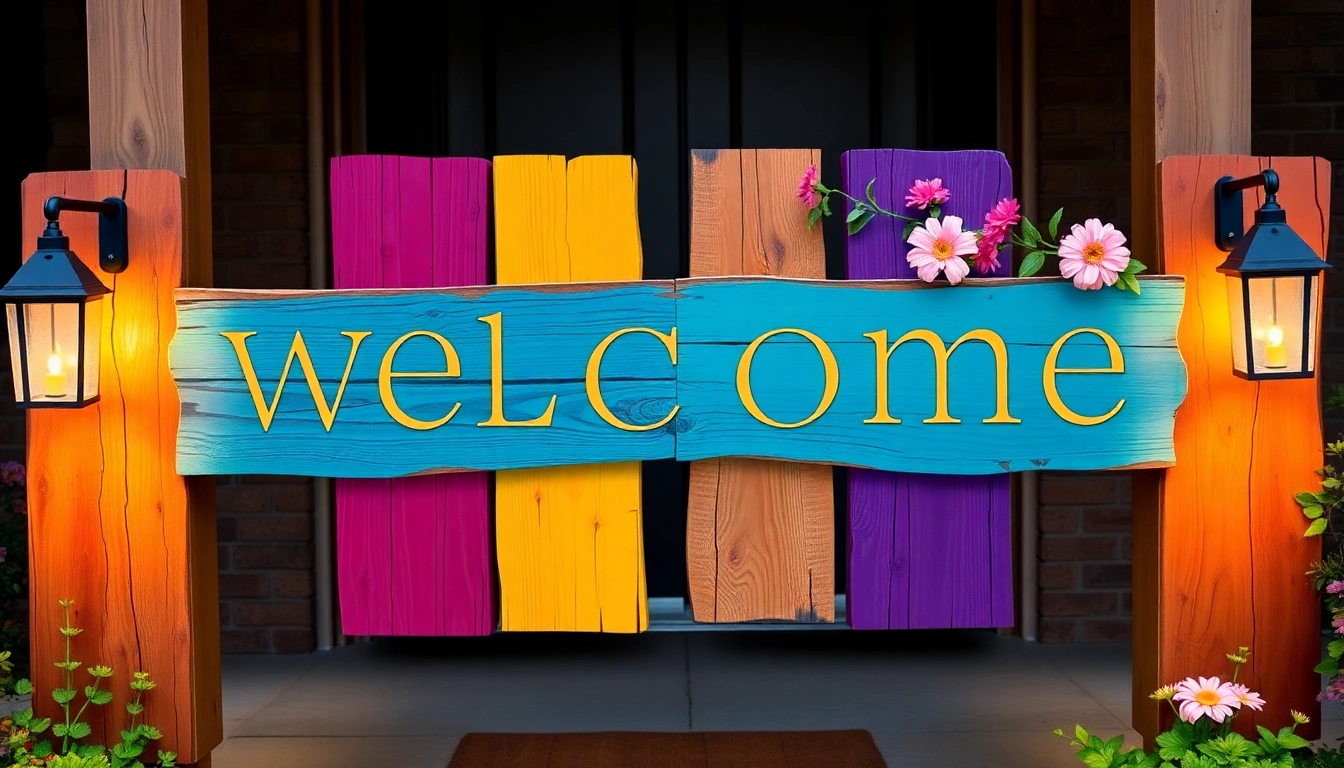Understanding the Role of Welcome Signs in Home Decor
Welcome signs have long served as both functional and decorative elements at the entrances of homes, venues, and outdoor spaces. They are more than simple markers; they are expressions of hospitality, personality, and style. In contemporary home decor, the significance of a well-chosen welcome sign extends beyond its initial greeting purpose, contributing to the overall aesthetic appeal of your front porch, entryway, or outdoor environment.
In today’s markets, the popularity of welcome signs is driven by their ability to adapt to various design themes, from rustic farmhouse charm to sleek modern minimalism. They serve as a visual focal point, establishing the mood and tone of the home. Moreover, they create an inviting atmosphere for guests, making their arrival a memorable experience.
Understanding their role in home decor involves appreciating their versatility. Whether made of wood, metal, or composite materials, welcome signs can be customized to reflect seasonal themes, personal interests, or the architectural style of your home. By integrating a thoughtfully selected welcome sign, homeowners can significantly enhance curb appeal, demonstrate personality, and even boost property value.
Why Welcome Signs Are Essential for Your Entryway
First impressions matter, especially in home decor. A welcoming sign at your front door or porch acts as a visual introduction, setting the tone for visitors and passersby. The right welcome sign can convey warmth, hospitality, and an inviting personality that makes guests feel at home before they even step inside.
Beyond aesthetic appeal, welcome signs serve practical functions. They mark the entrance clearly, guide visitors, and create a sense of boundary that delineates your property. Well-designed signs can also reflect seasonal changes or special occasions, keeping the exterior fresh and engaging year-round.
In addition to personalizing your space, they serve a strategic purpose in home security by clearly indicating property boundaries. A prominently placed welcome sign can also deter unwelcome visitors by signaling care and upkeep, which often correlates with neighborhood safety.
From a psychological perspective, a warm welcome sign fosters community spirit and social connection. It tells guests that their presence is appreciated and encourages a hospitable environment. Importantly, these signs have the power to transform a plain entry into a stylish focal point that complements your overall exterior decor.
Different Styles and Materials for Welcome Signs
The market for welcome signs today is diverse, offering a plethora of styles and materials tailored to various tastes and functional needs. Choosing the right type depends on your home’s decor, climate conditions, and personal preferences.
Styles of Welcome Signs
- Rustic: Characteristics include distressed wood, vintage lettering, and farmhouse elements. Perfect for country homes or rustic-themed exteriors.
- Modern: Sleek lines, minimalistic fonts, and contemporary materials like metal or acrylic, suitable for urban and modern architectures.
- Traditional: Elegant script fonts, classic motifs, and balanced designs that complement colonial or classic home facades.
- Whimsical: Playful graphics, fun fonts, and vibrant colors to give a lively and friendly vibe.
Materials of Welcome Signs
- Wood: Versatile, warm, and customizable. Handcrafted wooden welcome signs are highly popular and can be stained, painted, or left natural.
- Metal: Durable, weather-resistant, and modern in appearance. Common types include wrought iron, aluminum, and steel, often finished with weatherproof coatings.
- Acrylic and Plastic: Lightweight, affordable options for contemporary designs. Available in a broad spectrum of colors.
- Composite Materials: Combining the sturdiness of wood and ease of maintenance, ideal for outdoor use.
Each material offers unique benefits concerning durability, aesthetic appeal, and cost. For outdoor settings, weather-resistant options such as treated wood and powder-coated metal are advisable to ensure longevity.
Key Elements of an Effective Welcome Sign
An effective welcome sign combines visual appeal with readability and harmony with surroundings. Core elements include:
- Clear Messaging: Simple, legible text like “Welcome,” or personalized greetings such as “Hello, Beautiful,” ensure immediate understanding.
- Font Choice: Font styles should resonate with your overall decor; rustic signs may feature handwritten or serif fonts, while modern signs favor clean, sans-serif fonts.
- Color Palette: Colors should complement existing exterior hues. Contrasting text and background enhance visibility, especially in low-light conditions.
- Size and Proportion: The sign should be proportionate to your entryway—large enough to be seen from a distance yet not overwhelming.
- Decorative Elements: Borders, botanical accents, or motifs can enhance visual interest but should not clutter the design.
Focus on durability and visibility, especially if exposed to weather elements. Utilize weatherproof finishes and consider lighting options to maintain readability during night hours.
Choosing the Perfect Welcome Sign for Your Home
Matching Sign Styles with Your Front Porch Decor
Harmonizing your welcome sign with your exterior theme creates a cohesive look. For example, a rustic wooden sign complements a farmhouse porch with white siding and natural accents, while sleek metal signs pair well with modern brick facades.
Personalization Options to Reflect Your Family’s Style
Custom signage allows for creative expression. Incorporate your family name, favorite quotes, or seasonal messages to personalize your look. Many companies offer options for engraved, painted, or printed custom signs, adding a unique touch that encapsulates your personality.
Size and Placement Tips for Maximum Impact
Choosing the correct size is crucial: too small, and it’s unnoticed; too large, and it dominates the space artificially. Typically, a sign that measures around 24-36 inches wide and 8-12 inches high strikes a good balance for most front porches. Placement should be at eye-level or slightly above eye-level, near the door or gate, ensuring visibility from approaching vehicles or pedestrians.
Designing Custom Welcome Signs: Ideas and Inspiration
Popular Themes for Welcome Signs
Themes greatly influence the overall aesthetic. Some trending ideas include:
- Seasonal: Fall leaves, snowflakes, spring blooms to celebrate the time of year.
- Holiday: Christmas, Halloween, Easter, or personalized holiday greetings.
- Family or Name-based: Incorporate last names, monograms, or family quotes.
- Nature-inspired: Botanical motifs, rustic signs with natural elements.
- Humorous or Quirky: Funny sayings, playful fonts, humorous illustrations.
Color Palettes and Fonts That Convey Hospitality
Color psychology plays a role in welcoming. Soft neutrals, warm earth tones, and pastel shades evoke comfort and friendliness. Vibrant colors can energize the entrance but should be balanced with surroundings. Font choices should match your theme—cursive fonts for elegance, bold uppercase for modernity, or handwritten styles for casual charm.
DIY vs. Professional Custom Sign Production
DIY projects allow personalization and fun, suitable for creative homeowners with time and skills. Use wood or paint for a rustic look, or stencil lettering for a polished finish. However, professional manufacturers guarantee high-quality materials, weather resistance, and precise craftsmanship. Digital customization tools enable quick design mock-ups, and artisans can realize elaborate designs that are difficult to execute at home.
Placement and Maintenance of Your Welcome Sign
Best Locations for Outdoor Durability
Optimal placement involves selecting a spot sheltered from direct rain, intense sun, and high wind. Under a porch eave or sheltered entryway enhances longevity. Consider mounting on a sturdy post, wall, or decorative stand to prevent damage from accidental impacts.
Weatherproofing and Longevity Tips
Outdoor welcome signs must withstand diverse weather conditions. Use sealants or weatherproof paints on wooden signs. Metal signs benefit from powder coating or anti-rust finishes. Regular cleaning to remove dirt, pollen, and grime preserves the appearance, and occasional re-sealing prolongs the sign’s lifespan.
Enhancing Curb Appeal with Complementary Decor
Complement your welcome sign with potted plants, lanterns, seasonal wreaths, or pathway lighting. These elements create a layered, inviting aesthetic that elevates the overall curb appeal and ensures the welcome sign is part of a cohesive visual story.
Measuring Success: How Welcome Signs Enhance Guest Experience
Creating a Warm First Impression
A carefully selected welcome sign sets a positive tone from the moment guests arrive. It communicates that your home is cared for and hospitable. A warm, personalized message can evoke feelings of comfort and belonging, encouraging guests to relax and enjoy their time.
Increasing Home Curb Appeal and Property Value
Appealing exterior decor, including eye-catching welcome signs, can significantly boost your property’s curb appeal. In real estate settings, high-quality, stylish signs contribute to favorable first impressions and may positively influence property valuation.
Gathering Inspiration from Top-Performing Welcome Sign Designs
Reviewing successful designs—such as popular farmhouse signs with vintage fonts or modern metal pieces with sleek graphics—offers insights into what resonates with audiences. Pay attention to color schemes, typography, and materials that align with your style goals for maximum impact.



